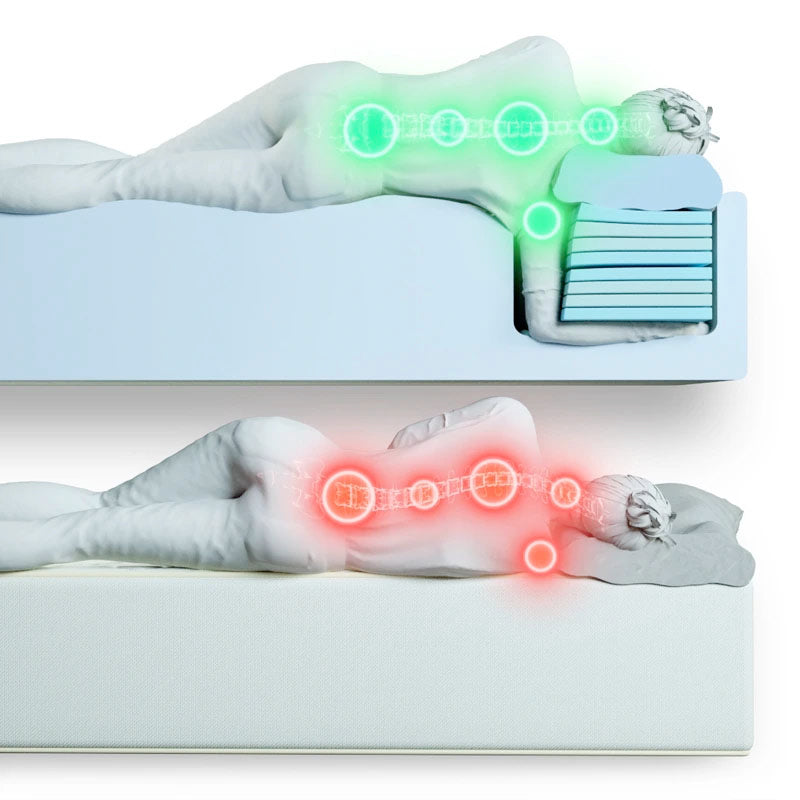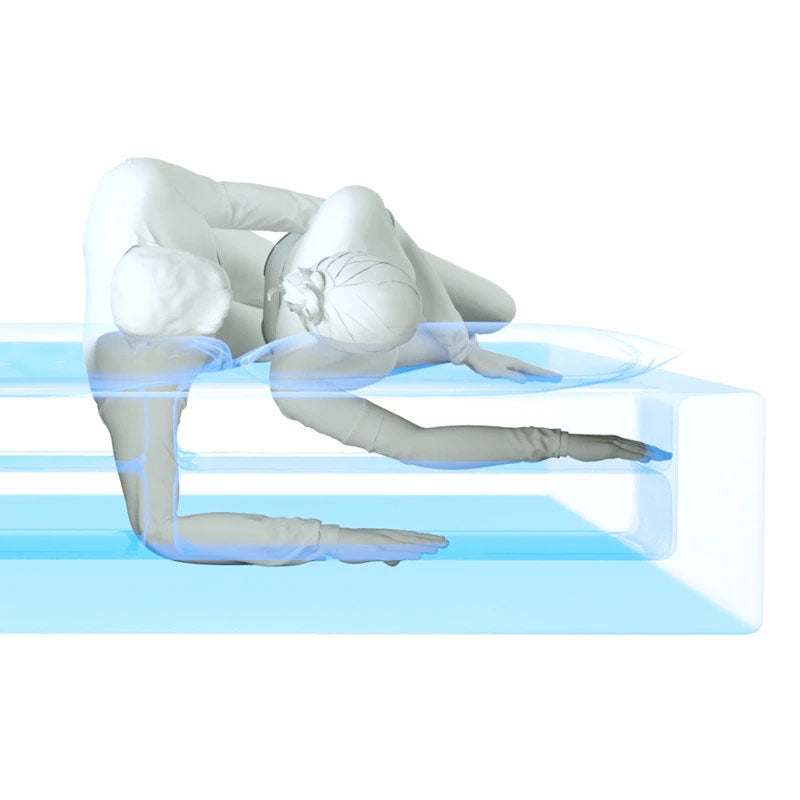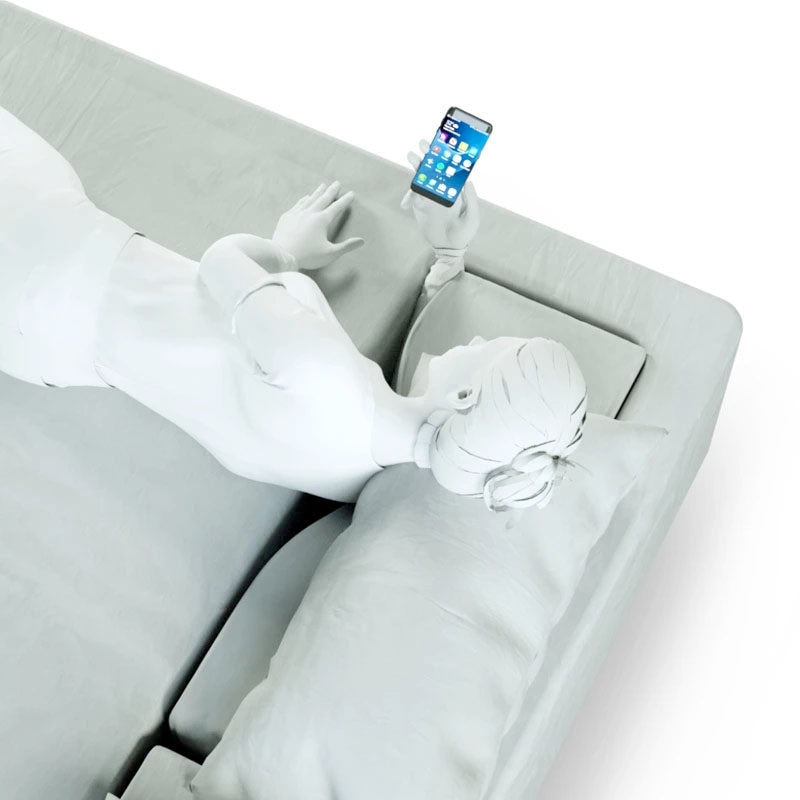Do you sleep with a partner? If so, do you cuddle with each other or prefer to stay on opposite sides of the bed?
The sleeping positions that couples assume at bedtime say a lot about their relationships. Approximately 86% of partners who sleep less than an inch apart are reportedly happy in their relationships. Comparably, 66% of couples who sleep at least 30 inches apart are happy.
The most popular sleeping positions for couples are:
- Back-to-back (42%)
- Facing in the same direction (31%)
- Facing one another (4%)
Physical touch while sleeping is important. Partners who sleep in close contact with each other are more satisfied in their relationships.
Plenty of research has been conducted about the body language connected to couples’ sleeping positions. The following are some examples of common couples’ sleeping positions and their meanings, and how SONU can give you your comfiest cuddled sleep yet.
1. Spooning
Are you the big spoon or the little spoon?
When you think of couples sleeping beside each other, we’ll bet this position is the first to come to mind. Spooning is a classic position where both partners lie on their sides, with one of them facing the other’s back. 18% of couples sleep in this position at night.
How closely you and your partner spoon may indicate how close your relationship is. Couples that spoon tightly are closer in their relationship than those that spoon further apart.
Spooning is ideal for the colder months, but it may be too hot to spoon with your partner in the spring and summer. Sleeping face to face and holding hands is a way to stay close to each other without overheating.
2. Intertwined
This sleeping position isn’t as complicated as it sounds.
Sleeping intertwined – also known as the lovers’ knot – is when two partners sleep face-to-face embracing each other and intertwining their legs. This position indicates that you and your partner are very close or that your relationship is new and you are learning to bond.
Nearly 8% of couples sleep intertwined. However, couples usually don’t stay in this same position all night long because it can make their legs fall asleep. After about ten minutes, they switch to a different position.
3. Back-to-Back
Many couples lay on their sides, sleeping back-to-back. There are additional names for this position depending on how close couples’ backs are to each other.
The “cherish” position is when the backs of the couples are touching. The liberty position is when their backs are not touching.
If one or both of the partners sleep in the fetal position, this could mean that they feel anxious in the relationship. If this is the case, they should work on strengthening their connection to each other before going to sleep.
Usually, couples who sleep back-to-back have been together a while and feel secure in their relationship. They prioritize their individual sleep comfort.
4. Head on Shoulder
In this position, one partner lies on their back with their arm around their partner, who places their head on the first partner’s shoulder. This position indicates closeness and protection, yet only 4% of couples sleep in it.
When people sleep in this position, it could mean that one of the partners feels stressed. To alleviate that stress, they sleep in the other partners’ arms, which gives them both a sense of security.
People don’t usually stay in this position all night. It can cause the protective partner’s arms to go numb. It’s also not the best position if you experience pain in your neck or spine; this position will exacerbate that pain.
5. Cliffhangers
The cliffhangers position is when partners sleep as far apart as they can on opposite sides of the bed, to the point that they might have limbs hanging off the bed.
Sleeping in this position could mean that there’s trouble brewing in your relationship. Maybe you had a disagreement, and now you want to be as far apart as possible. The cliffhangers position allows you to decompress.
Or, maybe it’s just too hot to sleep right next to each other. Sleeping apart when it’s hot can help cool you down.
What Are the Advantages of Sleeping With a Partner?
Sharing a bed with a partner is great for building emotional intimacy. The heart rhythms of happy couples synchronize when they sleep.
Sleeping with a partner can be good for your mental health. If you’re touching while asleep, oxytocin might be released, helping you feel more relaxed.
Some people sleep better with a partner than they do sleeping alone. Cosleeping could increase rapid eye movement (REM) sleep, which is crucial for sleep quality.
If you and your partner sleep in the nude, it’s a sign that your relationship is secure and you both have good self-esteem.
What Are the Disadvantages of Sleeping With a Partner?
Sometimes, sleeping with a partner isn’t ideal. If you have a partner who snores, gets up a lot throughout the night, or exhibits other disruptive behavior at night, it can reduce your sleep quality and make it hard for you to fall asleep in the first place. That’s why SONU’s mattress is made from a combination of motion transfer-reducing foam.
Sometimes, sleeping next to someone is just plain old uncomfortable. Sharing a bed might feel restrictive. You might feel pressure to sleep in a position that, while romantic, makes your body sore or stiff. SONU’s mattress is available in sizes Twin XL, Queen, King and California King, so you and your partner can choose a mattress with sufficient space for you both.
Over time, sleeping with a partner could either bring you closer to them or push you apart.
How Can I Improve Sleeping With My Partner?
Communication is always the first step for improving any situation with your partner.
Tell your partner which positions are most comfortable for you to sleep in early on. Establish your side of the bed. Choose a room temperature that’s comfortable for both of you to sleep in. Opt for a bedtime that works for both of you.
Figure out if either of you needs sleep aids to fall asleep. Maybe one of you needs white noise or pink noise to help you sleep. Maybe you need to read in bed a little bit to help you grow tired. Mention all of this upfront, so your partner knows what to expect when sleeping with you.
Purchase a bed that’s suitable for couples. That could mean choosing a bed made of flexible material, opting for a larger bed than you already have, or choosing a split bed that allows each of you to select different levels of firmness.
The SONU Sleep System is perfect for couples who enjoy cuddling while sleeping, as it features a patented Comfort Channel that allows side sleepers to immerse their lower arm and shoulder into the bed.
Upgrading your bedding can make a world of difference. It’s amazing how much new, high-quality pillows, sheets, and comforters can improve your sleep experience.
Don’t worry about social norms. While society suggests that partners should share a bed, that’s not ideal for everyone.
Some couples sleep with two beds in the same room, and some couples sleep in separate rooms. This doesn’t mean that their relationships aren’t healthy. In fact, their relationships might even improve by optimizing their sleep experience to meet their individual needs.
What Else Does Our Sleeping Position Tell Us?
Did you know that your sleep position is indicative of your personality type?
Extroverted sleepers like to sleep in positions that allow them to be close to their partners — sixteen percent of extroverts like spooning with their partners. Extroverts also like sleeping on their stomachs.
Introverts may prefer to sleep further away from their partners. A majority of introverts also like sleeping in the fetal position.
People who sleep in the fetal position may be more emotional and anxious than their peers. However, people that sleep in the semi-fetal position are usually well adjusted.
Stomach sleepers are said to have varying personality traits. They tend to be sensitive, anxious, impulsive, compulsive, and rigid. Some of them may feel insecure.
Back sleepers tend to be more confident and open. They could also be extroverts because back sleepers tend to be sensation-seeking.
Your sleep position can provide benefits for your health. For example, side sleepers may benefit from less snoring, reduced neck and back pain, and a decrease in gastroesophageal reflux disease (GERD). The position is recommended for anyone in their second or third trimester of pregnancy.
Conclusion
Most people don’t think about what their sleeping position says about their personalities or relationships. There is more evidence available to show how sleep positions affect your health.
This doesn’t mean that couples shouldn’t consider what their sleeping positions say about their relationships. Identifying your preferred co-sleeping positions may enlighten you and help you identify areas in your relationship that need improvement.
The most important thing is continuous, open communication with your partner to confirm your sleeping preferences. These preferences are subject to change over time. Regularly evaluating your co-sleeping needs can keep things fresh and interesting in your relationship.
If you and your partner aren’t getting quality sleep and you’ve identified your sleep preferences, it may be time to address the elements of your bedroom.
Adjust the atmosphere. Create a sleep routine. Consider purchasing a mattress that has been highly reviewed by couples, like the SONU negative space mattress.
The SONU will provide you and your partner with the comfort you never thought was possible.
Ready to check it out? Check out our customer reviews. From there, you can select the best SONU bed for you and your partner.
Sources
What Sleeping Positions Reveal About Relationships | Science | AAAS
Relationship Test: How Close Do You Sleep? | AARP
Common Couple Sleeping Positions and What They Mean | Sleep Foundation
Is it Better to Sleep on Your Side, Back, or Stomach? - Best Mattress Brand | Best Mattress Brand
What Your Sleeping Position Says About You | Sleep Foundation





























